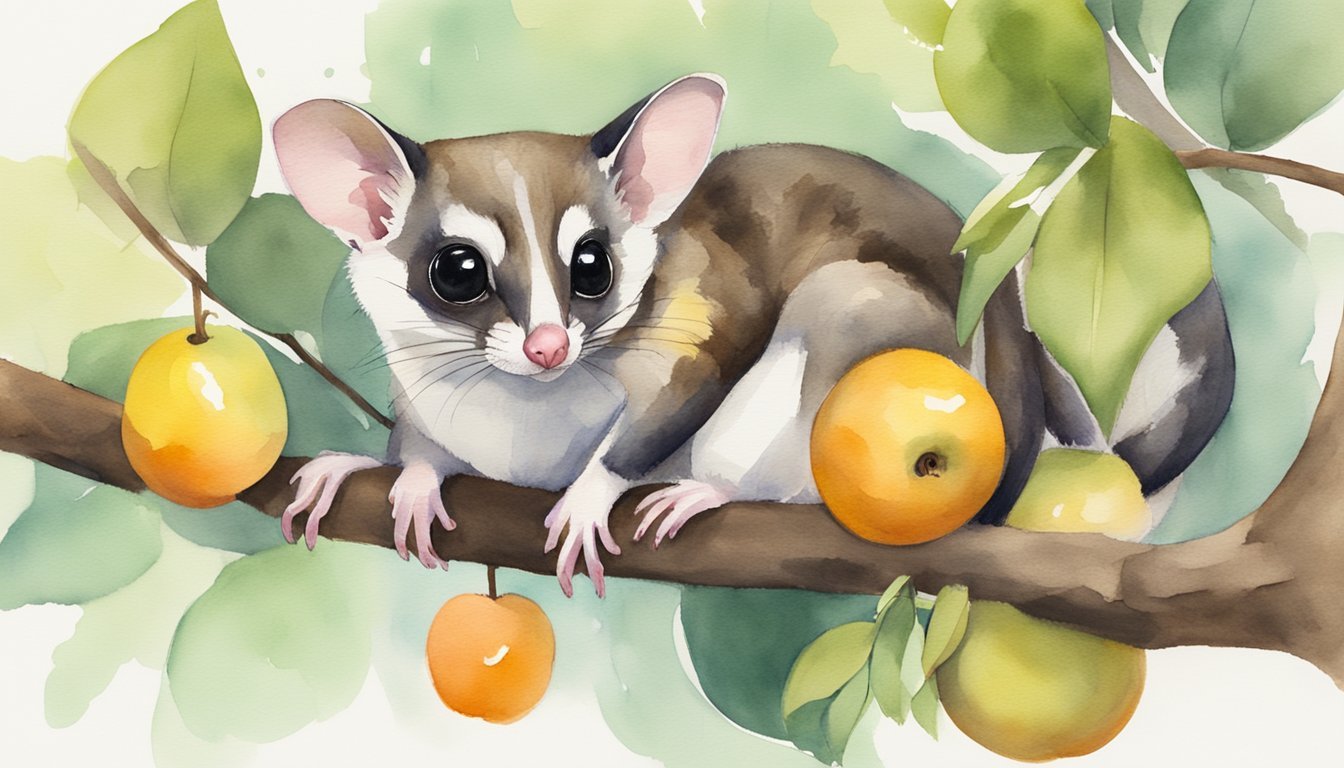Understanding Sugar Gliders
Sugar gliders are fascinating marsupial species known for their unique ability to glide through the air. They are mainly nocturnal and posses a distinctive membrane aiding in their gliding escapades.
Species Overview
Sugar gliders, scientifically known as Petaurus breviceps, are small marsupials indigenous to regions of Australia, Papua New Guinea, and Indonesia. Contrary to common belief, they are not rodents but belong to the same general family as koalas and kangaroos.
Physical Characteristics
Adult sugar gliders usually reach a size of about 24 to 30 centimeters from the nose to the tip of the tail, and weigh between 90 to 150 grams. Their most notable feature is the patagium, a skin membrane that extends from their forepaws to their hindpaws, which enables them to glide for distances of over 50 meters. The fur coat of a sugar glider is typically soft and grey with distinct black stripes that run from the snout to the mid-back, and they have cream-colored underbellies. Unique variations such as albino sugar gliders also exist, distinguished by a lack of pigmentation.
Habitat and Distribution
These arboreal creatures thrive in forested areas including eucalyptus forests and rainforests. The canopy layer of forests offers them an ideal habitat, providing both the high perches necessary for gliding and abundant sources of food. They nest in tree hollows lined with leaves and other soft materials.
Diet and Foraging
As omnivores, sugar gliders have a diverse diet comprising sap, nectar, gum, insects, and pollen. A notable food source is the acacia tree, among other native Australian flora. Foraging primarily at night, they use their excellent nocturnal vision and sense of smell to locate food, often covering wide areas of their arboreal habitat in search of sustenance.
More detailed insights into sugar glider behavior, diet, and habitats can be found within resources such as Wild Explained, National Geographic, and care guides from CoolWood Wildlife Park and Sugar Glider Zone.
How Does Sugar Glider Care Compare to Boa Constrictor Care for Optimal Pet Well-Being?
Caring for sugar gliders and boa constrictors involves distinct approaches tailored to their unique needs. While sugar gliders thrive in social, interactive environments, boa constrictors require careful temperature regulation and diet. To ensure optimal health, follow essential care tips for boa constrictors, including habitat setup and feeding schedules that cater to their specific requirements.
Caring for Sugar Gliders

Sugar gliders are fascinating marsupials, known for their gliding abilities and social behaviors. They require specific care to maintain their health and mimic their natural nocturnal and arboreal lifestyles.
Reproduction and Lifecycle
Sugar gliders breed once or twice a year with a gestation period of roughly 16 days. After birth, the tiny, undeveloped young, called joeys, crawl into the mother’s pouch to continue development. They spend around 60 to 70 days in the pouch before they begin to explore the outside world. The lifespan of sugar gliders in the wild is typically around 9-12 years, though they can live longer in captivity.
Behavior and Social Structure
These nocturnal animals are highly social, living in colonies that can number up to 30 individuals. The dominant male uses scent glands, located on his forehead and chest, to mark territory and members of the group. Sugar gliders communicate with a range of vocalizations and engage in social grooming, which also serves to strengthen group bonds. Their gliding flight is a standout aspect of their behavior, allowing them to escape predators, like kookaburras and goannas, and to forage effectively.
Health and Well-being
Maintaining a sugar glider’s health involves providing a balanced diet composed of fruits, vegetables, and protein. In captivity, diets should replicate the variety they would find in the wild, including insects and small vertebrates. Sugar gliders can enter a state of torpor in response to cooler temperatures or insufficient food. Regular veterinary care is essential, as they are prone to stress and health issues, especially when kept as pets.
Conservation Status
Sugar gliders are classified as “Least Concern” by the IUCN, though their populations are affected by habitat destruction due to bushfires and the expansion of plantations. Conservation efforts are crucial to ensure these creatures do not become threatened, as they play an integral role in seed dispersion and as a prey species in their natural ecosystems.
For more information on their dietary needs, consult guides from A Few Good Pets and Pet Keen. Passionate sugar glider enthusiasts can learn about their social habits at Pocket Pets. To understand the importance of their conservation, explore resources like The Complete Guide to Owning and Caring for a Sugar Glider.

